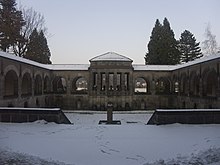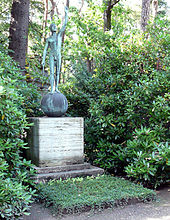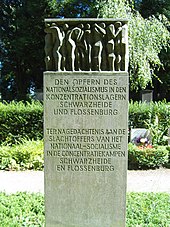Tolkewitz urn grove
The Tolkewitz municipal cemetery and urn grove is a forest cemetery in the Tolkewitz district of Dresden , where only urn burials take place. The cemetery is located next to the Johannisfriedhof on Wehlener Straße and is in municipal hands. With a size of 70,500 square meters, it is the sixth largest cemetery in Dresden . The cemetery crematorium was a popular tourist attraction in the 1920s, could be viewed for 25 pfennigs and was distributed on postcards. The Tolkewitz urn grove has been a listed building in its entirety since 1985.
history
In 1876, the first European crematorium opened in Milan. Two years later, the Gotha crematorium was the first to go into operation in Germany. In 1891 crematoriums followed in Heidelberg, later others in Hamburg , Jena and Offenbach am Main (1899).
In Saxony, cremation was only permitted by law in 1906. Shortly afterwards it was decided to build a crematorium in Dresden as well. In 1908 the city acquired a 30,000 square meter plot of land in Tolkewitz, which was still independent at the time, right next to the Johannisfriedhof. Construction of the crematorium began in 1909. The plans came from Fritz Schumacher , the construction management was carried out by Hans Erlwein . The facade design was done by Georg Wrba , the interior work was done by Georg Wrba and Otto Gussmann . In 1911 the building was completed as the 25th crematorium in Germany. The first cremation took place on May 22, 1911.

Fritz Schumacher designed the open urn hall and urn courtyard. The urn grove was laid out according to plans by the architects Willy Meyer and Fritz Schumacher. At that time, the Tolkewitz urn grove in Germany was the “first complete facility for cremations.” Nature and cemetery design form a symbiosis - when designing the cemetery, Schumacher was inspired, among other things, by the recently inaugurated forest cemetery in Munich . "The long, dark-lined avenue that leads to the crematorium presents itself like a 'via funeralis' and, like the building itself, is reflected in a narrow water basin."
Contemporaries also compared the design of the crematorium within the cemetery complex with the water basin in front of Arnold Böcklin's painting Die Toteninsel , which for Fritz Schumacher was the starting point of the “striving for a 'new monumentality', 'a solemn, grand architectural language'”, and in hung in his study.
From 1923 and 1929 the Tolkewitz urn grove was redesigned and expanded under the direction of the architect Paul Wolf . In 1924 the rosarium was built in the north of the cemetery, the columbarium from 1926 is still the only one in cemeteries in the Dresden area. From 1928 to 1929 the "New Park" was created, the eastern extension of the cemetery. There is also a spacious terrace area with the "pond of tears" in the middle. The new part is separated from the original area by an urn courtyard - today used as a memorial complex - as well as similarly laid out walls with graves in a row. Wolf also created ten fountains made of artificial stone that are used to water the grave plants. When redesigning the site, Wolf's aim was the perfect interplay of “architecture, garden art and sculpture”. The result was a cemetery which at its time served as a model for all of Germany and was even touted in travel guides as a “total work of art”, “whose mood is not matched by any other city's crematorium”.
In the early years of the GDR, the building of the former royal Saxon regional court in Dresden served as the central execution site for the GDR. The bodies of those executed there were brought to the Tolkewitz Urn Grove in the greatest of secrecy and cremated anonymously. The ashes were buried in "Collection Point C, Field III", where the urns of those executed are lying on an unplanted part of the collection point. In 1957 the central execution site was moved to Leipzig .
A new crematorium was put into operation in 2005 and meets today's environmental standards.
Graves
Funerary art
A large number of graves in the urn grove were created by well-known sculptors. Max Kühne created the grave of the art collector Felix Bondi (Grabfeld F), the sculpture on the grave stone of Max Immelmann and the urn design of the grave by Gotthardt Kuehl came from Peter Pöppelmann . Sascha Schneider created, among other things, the grave relief for the sculptor and painter Robert Spies (1886–1914).
Other tombs were designed by Hugo Lederer , Martin Pietzsch , Robert Ockelmann Oswin Hempel , Georg Wrba, Rudolf Kolbe , Gustav H. Wolff , Karl Albiker , Edmund Moeller , Arthur Bock , Ferdinand Liebermann and Max Hermann Fritz .
In the Tolkewitz urn grove, the variety of shapes and stylistic variants of urns can be observed in a special way .
Classic antique shape (material: Zöblitzer serpentinite )
Urn with gold-plated star elements (material: Elbe sandstone )
Memorials
Various memorials exist in the cemetery. In the large rosarium in the north of the cemetery there is a memorial stone for Soviet forced laborers. An urn yard not far from the crematorium is designed as a memorial for the victims of the Schwarzheide and Flossenbürg concentration camps .
On the western edge parallel to Wehlener Straße there are two memorials: to the southwest is the memorial for the victims of Stalinist tyranny and to the west of it the memorial for the euthanasia victims of the Pirna-Sonnenstein killing center .
A memorial stone not far from the crematorium commemorates the first cremation in 1911 and the first cremation after the reopening of the urn grove, which took place on January 21, 1946.
Personalities
- Heinrich Allmeroth (1901–1961), singer
- Eberhardt del'Antonio (1926–1997), writer
- James Aurig (1857-1935), photographer
- Heinrich Barkhausen (1881–1956), physicist and professor at the TH Dresden
- Paul Berger (1889–1949), sculptor
- Walter Beltz (1935–2006), religious scholar
- Max Bewer (1861–1921), writer
- Robert Burg (1890–1946), singer
- Wolfgang Dehler (1936–2003), actor and singer
- Felix Draeseke (1835–1913), composer and writer
- Arthur Esche (1857–1940), lawyer and politician
- Fritz Foerster (1866–1931), chemist and rector of the TH Dresden
- Max Förster (1867–1930), civil engineer
- Siegwart Friedmann (1842–1916), actor
- Erhard Frommhold (1928–2007), art historian (buried anonymously)
- Harry Gravelius (1861–1938), meteorologist and rector of the TH Dresden
- Otto Gussmann (1869–1926), monumental painter
- Marie Hankel (1844–1929), writer and promoter of Esperanto
- Georg Heinsius von Mayenburg (1870–1930), architect
- Heinrich Heitsch (1916–1986), Lieutenant General
- Max Herfurt (1872–1932), architect
- Ulrike Hessler (1955–2012), opera director and author
- Otto Heubner (1843–1926), internist and pediatrician (Urnenhof)
- Friedrich von Heyden (1838–1926), chemist
- Max Immelmann (1890–1916), military aviator
- Ernst Jennrich (1911–1954), executed after the popular uprising of June 17, 1953, urn transferred to Magdeburg after the fall of the Berlin Wall
- Willy Katz (1878–1947), medic
- Claus Koepcke (1831–1911), civil engineer, creator of the Blue Wonder
- Rudolf Krügener (1847–1913), chemist and entrepreneur
- Gotthardt Kuehl (1850–1915), painter and professor at the Dresden Art Academy
- Kurt Liebmann (1897–1981), writer
- Friedrich Merkel (1892–1929), refrigeration technician
- Siegfried Meurer (1908–1997), mechanical engineer
- Lotte Meyer (1909–1991), actress
- Richard Mollier (1863–1935), professor of mechanical engineering, rector of the TH Dresden
- Gustav Neuring (1879–1919), politician
- Alexander Parvus (1867-1924), journalist
- Bernhard Pattenhausen (1855–1926), geodesist , director of the Mathematical-Physical Salon , rector of the TH Dresden
- Erich Ponto (1884–1957), actor
- Walter Reinhold (1898–1982), sculptor
- Etha Richter (1883–1977), animal sculptor
- Siegfried Rüger (1933–2007) transport scientist
- Clara Salbach (1861–1944), actress
- Karl Scheidemantel (1859–1923), singer
- Gerhard Schill (1925–2000), politician
- Max Schippel (1859–1928), journalist
- Otto Schubert (1878–1968), architect
- Oskar Seyffert (1862–1940), founder of the Museum of Saxon Folk Art in Dresden
- Robert Spies (1886–1914), sculptor
- Jean Louis Sponsel (1858–1930), director of the Kupferstichkabinett , the Historical Museum and the Green Vault
- Robert Sputh (1843–1913), inventor of the beer mat
- Hans Erdmann Franz Stosch-Sarrasani (1873–1934), clown and circus director
- Walter Thürmer (1896–1971), politician
- Heinrich Tscharmann (1859–1932), architect
- Paul Wiecke (1862–1944), actor, director and theater director
- Karl Woermann (1844–1933), lawyer and art historian
literature
- Jens Börner et al .: 100 years of the crematorium and urn grove Dresden-Tolkewitz . Sax Verlag, Beucha / Markkleeberg 2011.
- Marion Stein (text), Thomas Claus (photos): Friedhöfe in Dresden . Verlag der Kunst, Dresden 2000, ISBN 90-5705-130-3 .
- Karin Fischer: Graves of the "alma mater dresdensis" in cemeteries in Dresden and the surrounding area . 2nd supplemented edition. TU Dresden, Dresden 2003.
- Bernd Beyer , Jens Börner, Christian Mögel (edit.): Culturally and historically valuable tombs and graves of important personalities on the urn grove Dresden-Tolkewitz . Cemetery guide. Municipal cemetery and funeral services, Dresden 2009.
Web links
- Municipal cemetery and funeral services in Dresden: The Tolkewitz urn grove
- Urnenhain Tolkewitz on dresdner-stadtteile.de
Individual evidence
- ↑ As of 2000, cf. Stein, p. 175.
- ↑ Stein, p. 131.
- ↑ Stein, p. 133.
- ↑ a b Stein, p. 135.
- ↑ Bernd Beyer , Jens Börner, Christian Mögel (arrangement): Culturally and historically valuable tombs and graves of important personalities on the urn grove Dresden-Tolkewitz . Cemetery guide. Municipal cemetery and funeral services, Dresden 2009.
- ↑ Stein, p. 136.
- ↑ Cf. Christian Weller: Reform of the lifeworld through culture . In: Hartmut Frank (Ed.): Fritz Schumacher. Reform culture and modernity . Hatje, Stuttgart 1994, p. 42.
- ↑ See Stephan Hirzel (ed.): Grave and cemetery of the present . Callwey, Munich 1927, p. 53.
- ^ Council of the City of Dresden (Ed.): Dresden. The book of the city . Industrie- und Verkehrsverlag, Dresden 1924, p. 35.
- ↑ Executions: Large white envelope , accessed August 12, 2015.
Coordinates: 51 ° 2 ′ 12.6 ″ N , 13 ° 49 ′ 10.7 ″ E









